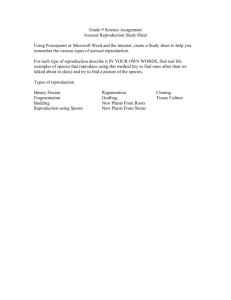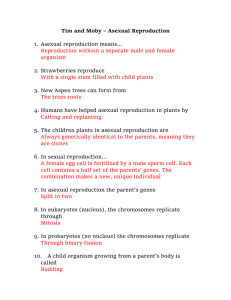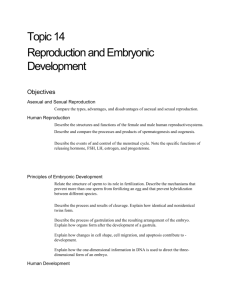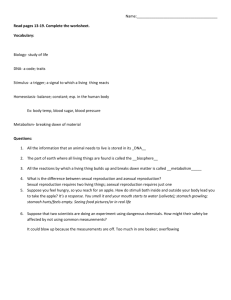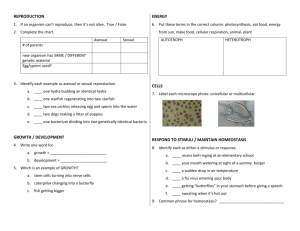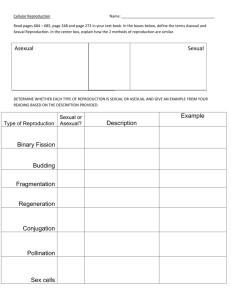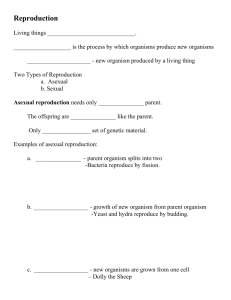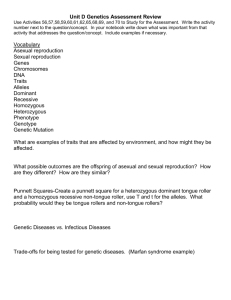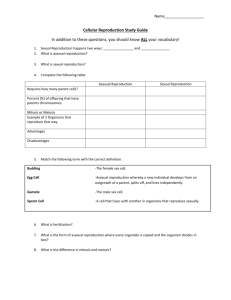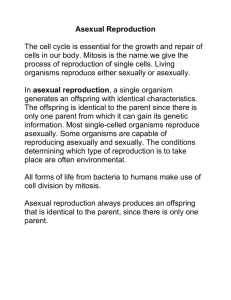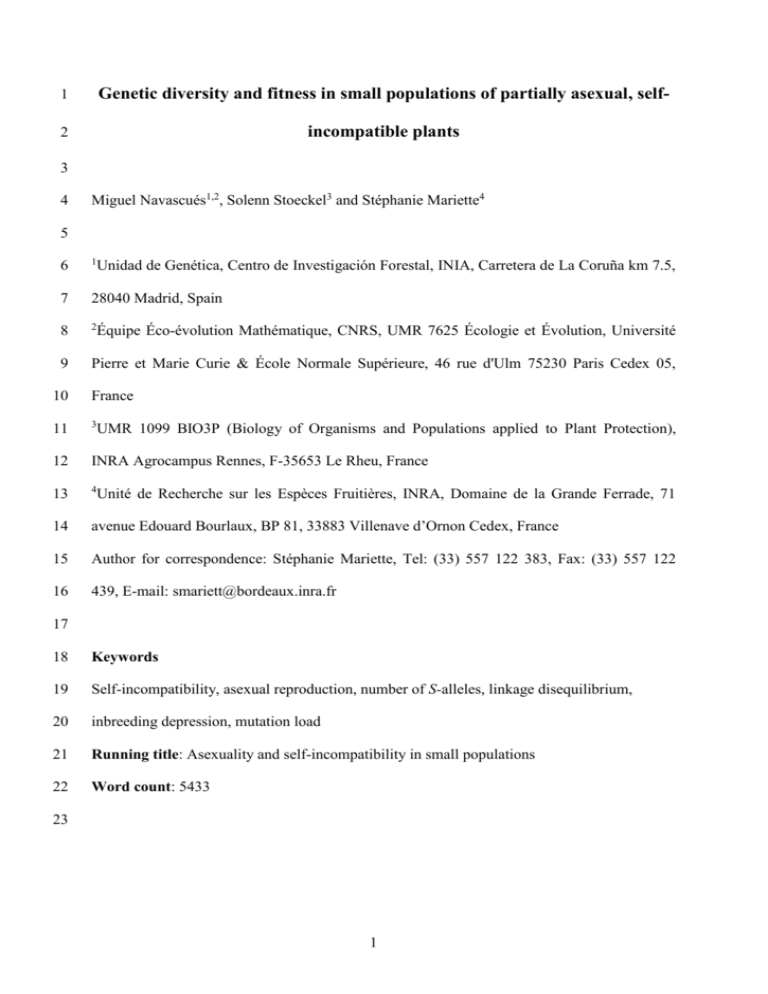
1
Genetic diversity and fitness in small populations of partially asexual, self-
2
incompatible plants
3
4
Miguel Navascués1,2, Solenn Stoeckel3 and Stéphanie Mariette4
5
6
1
7
28040 Madrid, Spain
8
2
9
Pierre et Marie Curie & École Normale Supérieure, 46 rue d'Ulm 75230 Paris Cedex 05,
Unidad de Genética, Centro de Investigación Forestal, INIA, Carretera de La Coruña km 7.5,
Équipe Éco-évolution Mathématique, CNRS, UMR 7625 Écologie et Évolution, Université
10
France
11
3
12
INRA Agrocampus Rennes, F-35653 Le Rheu, France
13
4
14
avenue Edouard Bourlaux, BP 81, 33883 Villenave d’Ornon Cedex, France
15
Author for correspondence: Stéphanie Mariette, Tel: (33) 557 122 383, Fax: (33) 557 122
16
439, E-mail: smariett@bordeaux.inra.fr
UMR 1099 BIO3P (Biology of Organisms and Populations applied to Plant Protection),
Unité de Recherche sur les Espèces Fruitières, INRA, Domaine de la Grande Ferrade, 71
17
18
Keywords
19
Self-incompatibility, asexual reproduction, number of S-alleles, linkage disequilibrium,
20
inbreeding depression, mutation load
21
Running title: Asexuality and self-incompatibility in small populations
22
Word count: 5433
23
1
24
Summary
25
How self-incompatibility systems are maintained in plant populations is still a debated issue.
26
Theoretical models predict that self-incompatibility systems break down according to the
27
intensity of inbreeding depression and number of S-alleles. Other studies have explored the
28
role of asexual reproduction in the maintenance of self-incompatibility. However, the
29
population genetics of partially asexual, self-incompatible populations are poorly understood
30
and previous studies have failed to consider all possible effects of asexual reproduction or
31
could only speculate on those effects. In the present study, we investigated how partial
32
asexuality may affect genetic diversity at the S-locus and fitness in small self-incompatible
33
populations. A genetic model including an S-locus and a viability locus was developed to
34
perform forward simulations of the evolution of populations of various sizes. Drift combined
35
with partial asexuality produced a decrease in the number of alleles at the S-locus. In addition,
36
an excess of heterozygotes was present in the population, causing an increase in mutation
37
load. This heterozygote excess was enhanced by the self-incompatibility system in small
38
populations. In addition, in highly asexual populations, individuals produced asexually had
39
some fitness advantages over individuals produced sexually (due to the increased
40
heterozygosity, sex produces the homozygosis of deleterious alleles). Our results suggest that
41
future research on the role of asexuality for the maintenance of self-incompatibility will need
42
to (1) account for whole genome fitness (mutation load generated by asexuality, self-
43
incompatibility and drift) and (2) acknowledge that the maintenance of self-incompatibility
44
may not be independent of the maintenance of sex itself.
45
2
46
Introduction
47
Hermaphroditic plant species reproduce with variable rates of selfing, ranging from strict
48
selfing to strict outcrossing (Barrett, 2002). Self-incompatibility (SI) is a reproductive system
49
that prevents self-fertilization. In the case of heteromorphic self-incompatibility, distinct
50
morphologies result in distinct compatibility groups, whereas in the case of homomorphic
51
self-incompatibility, compatible individuals cannot be distinguished by their morphology (de
52
Nettancourt, 1977). Most SI systems depend on physiological mechanisms that prevent pollen
53
germination or pollen tube growth. In sporophytic self-incompatibility (SSI) systems, the
54
compatibility of a pollen grain depends on the diploid genotype of the plant that produced it.
55
In gametophytic self-incompatibility (GSI) systems, the compatibility of a pollen grain
56
depends on its haploid genotype. GSI is more widespread than SSI (Glémin et al., 2001).
57
Fisher (1941) showed that self-fertilization should have a selective advantage because a
58
selfing genotype will transmit more copies of its genome than a non-selfing genotype (this has
59
been termed the automatic advantage of selfing). However, numerous studies have shown that
60
inbred offspring are less fit than outbred offspring. The relative decrease in the mean fitness
61
of selfed versus outcrossed individuals (inbreeding depression) is generally recognized as the
62
only main factor that counterbalances the selective advantage of selfing (Charlesworth and
63
Charlesworth, 1987).
64
Consequently, the level of inbreeding depression in populations should play a determining
65
role in the evolution of SI systems. Inbreeding depression decreases as population size
66
becomes smaller due to reduced polymorphism for selection to act on (Bataillon and
67
Kirkpatrick, 2000). Charlesworth and Charlesworth (1979) showed that the number of S-
68
alleles also plays a role in maintaining SI, since a low number of alleles will limit the number
69
of compatible crosses in the population. A decrease in population size can also cause a
70
reduction in the number of S-alleles (Brennan et al., 2003), and a self-compatible mutant can
3
71
be positively selected for (Reinartz and Les, 1994). Thus, small populations may be
72
particularly prone to the breakdown of SI due to weak inbreeding depression and low
73
numbers of S-alleles. However, small self-incompatible populations may maintain high levels
74
of inbreeding depression due to a sheltered load of deleterious alleles linked to the S-locus
75
(Glémin et al., 2001). The existence of a sheltered load has been demonstrated experimentally
76
in Solanum carolinense by Stone (2004) and Mena-Alí et al. (2009).
77
Overall, under a wide range of conditions, SI can evolve to self-compatibility. In effect, the
78
loss of SI systems is very frequent in plant evolution (Igic et al., 2008). However, the reasons
79
for which some species maintain a SI system while other species lose it are not completely
80
understood. It has been suggested that asexual reproduction, “when an individual produces
81
new individuals that are genetically identical to the ancestor at all loci in the genome, except
82
at those sites that have experienced somatic mutations” (de Meeûs et al., 2007), plays a role in
83
the maintenance or breakdown of SI. Two studies suggest that asexuality could relieve the
84
main selective pressures that favour the breakdown of SI. First, Chen et al. (1997) showed in
85
Australian Droseraceae that all self-incompatible taxa have effective forms of asexual
86
reproduction, whereas the obligatory sexual annual taxon, Drosera glanduligera, is self-
87
compatible. Their interpretation is that self-incompatible forms accumulate recessive lethal
88
polymorphisms, especially in association with biparental inbreeding generated by elevated
89
levels of asexual reproduction. The hypothetical high genetic load constitutes the selective
90
pressure that maintains the outbreeding mechanisms. Second, Vallejo-Marín and O'Brien
91
(2007) hypothesized that asexuality could provide reproductive assurance in cross-fertilizing
92
species subject to pollen limitation. They predicted that cross-fertilizing species subject to
93
pollen limitation would often have some means of asexual reprduction, and they found a
94
strong correlation between self-incompatibility and asexuality in Solanum (Solanaceae).
95
Conversely, Young et al. (2002) developed a contrasting hypothesis for the case of Rutidosis
4
96
leiolepis in which they found SSI and high rates of asexual reproduction. They suggested that
97
increased asexual reproduction causes mate limitation by reducing genotype diversity at the S-
98
locus, favouring a breakdown of self-incompatibility.
99
The net effect of asexual reproduction on the maintenance or breakdown of SI systems is
100
therefore still unknown. Moreover, it is unclear to what extent the effects of asexual
101
reproduction discussed by the various authors are actually present in partially asexual, self-
102
incompatible populations. Theoretical studies have described the effects of partial asexuality
103
on the inbreeding depression of self-compatible populations (Muirhead and Lande, 1997) and
104
the number of S-alleles (Vallejo-Marín and Uyenoyama, 2008). However, no model has been
105
developed so far to study the joint effect of asexuality, self-incompatibility and drift on the
106
evolution of diversity and fitness parameters for a hermaphroditic species. Using individual-
107
based simulations, we investigated the effect of (i) partial asexual reproduction and drift on
108
diversity at the S-locus, (ii) combined asexuality, self-incompatibility and drift on the
109
frequency of deleterious alleles. Thus, our main goal was to characterise the dynamics of two
110
key factors (number of S-alleles and inbreeding depression) for the maintenance of SI in
111
partially asexual, self-incompatible populations. It was not the aim of this work to estimate
112
the probability of invasion of self-compatible alleles or other modifiers of reproduction.
113
114
Materials and Methods
115
Genetic model
116
The model considered in this study was based on the model developed by Glémin et al.
117
(2001). This model consists of a population of N (four population sizes evaluated: 25, 50, 100
118
and 1000) diploid hermaphroditic individuals with a GSI system. In addition, our model also
119
included asexual reproduction at rate c (probability that an individual is generated by asexual
120
reproduction, seven values evaluated: 0, 0.5, 0.8, 0.9, 0.99, 0.999 and 1). We considered an
5
121
asexual reproduction event as the production of a new independent individual that is an exact
122
copy of the parental individual (or only different by somatic mutation) (e.g. de Meeûs et al.,
123
2007). As in Glémin et al. (2001), each individual genome possessed the S-locus, which
124
regulated SI, and a viability locus, whose state determined individual fitness. Two neutral loci
125
were also included for reference. The four loci were considered to be physically unlinked and
126
were inherited independently through sexual reproduction.
127
Sexual reproduction events were controlled by the S-locus: crosses between individuals were
128
only possible when the S-allele carried by the pollen grain was different from both S-alleles of
129
the pistil (i.e. at least three different S-alleles were necessary in the population for sexual
130
reproduction to occur). To focus on effects specifically attributable to asexuality on the
131
maintenance and breakdown of SI, we assumed unlimited pollen availability and that sexual
132
crosses were always fruitful. Thus, sexual reproduction was only limited when asexuality and
133
genetic drift reduced the number of S-alleles to less than three within a population. In this
134
case, independent of the original rate of asexual reproduction, all individuals reproduced
135
asexually (c=1) until mutation introduced a third S-allele. Then, c was reset to its original
136
value.
137
Individual fitness, f, was determined by the viability locus, which had two alleles A and a.
138
Strength of the dominance of allele A over deleterious allele a was regulated by the
139
dominance coefficient h, and strength of the selection against a was regulated by the selection
140
coefficient s. Thus, relative fitness of genotypes were: fAA=1, fAa=1-hs and faa=1-s (0<s<=1
141
and 0<h<= 1/2). Three selection regimes at the viability locus were considered: (i) a neutral
142
case, to be able to study the effects of the interaction between SI and asexuality without the
143
interference of selection, where parameters s and h were set to zero; (ii) a case of mildly
144
deleterious and partially recessive mutations, for which values assigned to s and h were
6
145
respectively 0.1 and 0.2; and (iii) a case of highly recessive lethal mutations, values assigned
146
to s and h were respectively 1 and 0.02.
147
Mutations were allowed in all loci. Neutral loci mutated at rate μN=10-3, following a k-allele
148
model (k=100). Mutation at the S-locus followed an infinite-allele model (Kimura and Crow,
149
1964) with rate μS; three values were considered for this rate (μS=10-3, 10-4 and 10-5 as in
150
Glémin et al., 2001). Mutations at the viability locus occurred at rate μ1=10-3 from A to a and
151
at rate μ2=10-4 from a to A.
152
153
Individual-based simulations
154
Forward-time simulations of a population of N diploid individuals with no overlapping
155
generations were performed. Simulations started with all individuals carrying two unique
156
alleles at the S-locus (2N different S-alleles in the whole population), alleles A or a randomly
157
assigned (with equal probability, 0.5) to the viability locus and any of the k alleles (k=100)
158
randomly assigned (with equal probability, 1/k) to the two neutral loci.
159
At each generation, the number of individuals generated by asexual reproduction, x, was
160
drawn from a Poisson distribution with mean Nc, and the remaining N-x individuals were
161
generated by sexual reproduction (parents contributing to these two types of offspring were
162
not determined in this step). Genotypes of the N individuals were generated one by one. If a
163
given individual originated by asexual reproduction, a genotype i was randomly drawn from
164
all individuals of the previous generation. That genotype was assigned to the individual with a
165
probability equal to the fitness of genotype i; this will be called the selection step. If the
166
genotype was not successfully assigned, the genotype draft and the selection step was
167
repeated until a genotype passed the selection step. If the individual originated by sexual
168
reproduction, the simulation followed a different procedure. First, an individual from previous
169
generation was randomly drawn to act as a mother and the ovule haploid genotype was
7
170
randomly generated. Then, a second individual was drawn to act as a father and the pollen
171
haploid genotype was randomly generated. If the S-allele at the pollen grain was not different
172
from both S-alleles of the mother (i.e. incompatible pollen), the pollen was discarded. New
173
fathers and pollen grain genotypes were generated until a compatible cross was obtained (i.e.
174
pollen availability was unlimited). Then, a diploid genotype i was generated from the haploid
175
genotypes of the ovule and the pollen. The selection step was carried out on genotype i as in
176
the case of asexual reproduction; if the genotype was not assigned the process was repeated
177
by drawing two new parents until a genotype was able to pass the selection step. Once all N
178
genotypes were selected, mutations were applied to each individual. The numbers of mutants
179
at the S-locus and at the two neutral loci were drawn from Poisson distributions with means
180
2NμS and 2NμN respectively. At the viability locus, a mutant was formed with a probability μ1
181
if the allele was A and a probability μ2 if the allele was a. The rate of asexual reproduction
182
was a fixed parameter of our model and did not change with the selection process.
183
184
Monitored genetic indices
185
Simulations were run for 50 000 generations before beginning to monitor the genetic indices,
186
this allowed monitored indices to become stable and avoided the influence of initial
187
conditions in their values (Glémin et al., 2001). From generation 50 000, indices were
188
calculated every 3 000 generations until 107 000 generations (i.e. 20 times). For the same
189
combination of parameters, 50 replicates of the simulations were performed providing 1 000
190
(indices calculated 20 times in each of the 50 replicates) evaluations of the monitored
191
variables for each set of parameter values. Indices were calculated from all genotypes of the
192
population (i.e. they were not estimates, but the true values of the population).
193
Genetic diversity indices: For each locus we calculated the number of alleles (na), allele
194
pi , where pi was the frequency of allele),
frequencies, effective number of alleles ( ne 1
na
i1
8
2
195
expected heterozygosity ( He 11ne ), observed heterozygosity (Ho, proportion of
196
H
H
heterozygous individuals) and the inbreeding coefficient ( F
IS
e
oH
e). Theoretical
197
predictions for some of these indices were obtained from the work of several authors for some
198
of the scenarios considered:
199
a) Vallejo-Marín and Uyenoyama (2008) studied the effects of partial asexuality in the
200
number of alleles of the S-locus using a diffusion approximation and found that the number of
201
common alleles (nc, which is approximately equivalent to the effective number of S-alleles,
202
ne, Takahata, 1990) is determined by:
Mn
n
1
c
c
c
2
Mn
n
1
n
1
n
2
(
n
1
)(
n
2
) 2
c
c
c
c
c
1
c e
1
2
Mn
n
1
n
2
Mn
n
1
Mn
n
c
c
c
c
c
c
c
2
Mn
203
(1)
204
where MN1c and 2NS . This equation was solved numerically to obtain the
205
expected effective number of S-alleles in the simulations without selection on the viability
206
locus.
207
b) Glémin et al. (2001) obtained the expected FIS for a neutral locus linked to the S-locus as:
208
(2)
209
where fS is the scaling factor of the genealogy of the S-locus and r’ is the net recombination
210
rate between the two loci. For the case of partial asexuality, the number of common alleles
211
1
2
f
n
1
S
c
F
2
IS
1
n
2
f
n
1
4
Nr
'
n
1
c
S
c
c
2
n
n
1
n
2
c
c
c
S
was given by Equation 1 and the scaling factor was f
4
2
Mn
n
1
n
2
c
c
c
212
(Vallejo-Marín and Uyenoyama, 2008). To correct for the reduction of recombination due to
213
asexuality, we used r'r1c, where r was the recombination rate during sexual
214
reproduction (i.e. r=0.5 for unlinked loci). This approach ignored mutation on the neutral
215
locus.
9
216
c) Finally, an expression of the expected FIS of a neutral locus in a self-compatible, partially
217
asexual population was derived following Balloux et al. (2003):
218
(3)
219
where 1N and s is the selfing rate. Selfing rate in Balloux et al. (2003) model is
220
defined as the rate of self-fertilization of individuals; thus a fertilization event between two
221
individuals from the same genet is considered an outcrossing event. Under random mating,
222
s=1/N and for negligible mutation rates, γ=1.
223
Linkage disequilibrium: The linkage disequilibrium between pairs of loci (S-locus-viability
224
locus and the two neutral loci) was studied with the correlation coefficient between two loci,
225
RGGD, developed by Garnier-Géré and Dillmann (1992) which is particularly appropriate for
226
partially asexual diploids (de Meeûs and Balloux, 2004).
227
Fitness: Mean fitness of the population ( W ) was calculated from the genotype frequencies as
228
W
f
(
AA
)
1
f
(
Aa
)
1
hs
f
(
aa
)
1
s
, and the average fitness of individuals
229
potentially produced by selfing (Ws), outcrossing (Wo) and asexuality (Wa) were calculated as
230
1
1
1
W
f
(
AA
)
1
f
(
Aa
)
1
1
hs
1
s
f
(
aa
)
1
s
s
,
4
2 4
231
2
2
W
1
p
(
1
hs
)
2
p
p
(
1
s
)
p
(where pA and pa are the frequencies of alleles
o
A
A
a
a
232
A and a) and Wa W . Inbreeding depression (δ) and mutation load (L) were calculated as
233
1W
s W
o and L 1W . In addition, we compared the fitness of individuals produced
234
by asexual reproduction (Wa) to the fitness of individuals produced sexually, using the ratio
235
Wo/Wa. Ws, Wo and Wa were calculated as the fitness of potential offspring if all individuals
236
were produced by selfing, by outcrossing and asexually, respectively. However, these modes
237
of reproduction might not be actually present in the different scenarios considered (e.g. in
1
c
Ns
1
F
IS
2
N
1
cN
(
s
2
)
Ns
2
10
238
self-incompatible populations, no selfing occurs, but potential Ws and inbreeding depression
239
can be calculated).
240
Fixation probabilities: To interpret the results, we calculated the probabilities of four events:
241
fixation of alleles A and a in the viability locus, ‘fixation’ of viability locus heterozygote (Aa)
242
and fixation of a genotype in the S-locus (reduction of number of S-alleles to two, this was
243
only monitored in self-incompatible populations). These fixation probabilities were estimated
244
on 1 000 evaluations of the monitored variables as the proportion of times in which pa=0,
245
pa=1 and Ho=1 for the viability locus, or n=2 for the S-locus.
246
247
Results
248
Effect of asexuality and drift on linkage disequilibrium between loci
249
Probably the most obvious effect of partial asexual reproduction was the reduction of
250
recombination. Asexuality generated identical genotypes in offspring, so allele associations
251
were transmitted in the same way that they would be transmitted if they were physically
252
linked throughout the whole genome. In fully asexual populations, maximum linkage
253
disequilibrium was expected (equivalent to the linkage disequilibrium between fully linked
254
loci) and in partially asexual populations, recombination was reduced proportionally to the
255
rate of asexual reproduction. Figure 1 shows how non-random associations of alleles
256
increased with asexual reproduction rates. Linkage disequilibrium levels also depended on
257
population size because drift produced a departure from the expected values of frequencies of
258
allele combinations (Figure 1). Strong drift might have even caused some combinations of
259
alleles to be absent in the population.
260
In small populations, some generations with complete allelic association started to appear at
261
asexual reproduction rates of 0.8 and were predominant at rates of 0.99 and higher. In larger
262
populations, complete allelic association was only found in the fully asexual scenario. These
11
263
associations of alleles were observed between loci subject to selection and between neutral
264
loci, which showed that linkage disequilibrium was not a product of selective processes
265
(Figure 1a and Figure 1b).
266
Physical linkage between the S-locus and loci with deleterious alleles can decrease the
267
number of S-alleles (Uyenoyama, 2003). It can also dramatically increase inbreeding
268
depression in small populations (Glémin et al., 2001). Therefore, for the present model, it was
269
important to discern whether the linkage disequilibrium generated by asexual reproduction is
270
sufficient for the selective forces of the S-locus to interact with the viability locus. The results
271
are presented below taking this perspective into account.
272
273
Effect of asexuality and drift on diversity parameters: number of S-alleles and heterozygote
274
excess
275
The effective number of S-alleles decreased with asexuality (Figure 2) as shown analytically
276
by Vallejo-Marín and Uyenoyama (2008). Balancing selection on the S-locus only occurred
277
during sexual reproduction events. Since these events were scarce at high rates of asexual
278
reproduction, the influence of balancing selection (which promotes high allelic diversity) on
279
the population diminished. This can temporarily stop sexual reproduction by reducing the
280
number of S-alleles to two (i.e. fixation of an S-locus genotype, Table 1).
281
No significant differences in the number of S-alleles were found among the three different
282
selection regimes for the viability locus (frequency distributions of the number of S-alleles
283
among different selection regimes were undistinguishable in a Kolmogorov-Smirnov test, P-
284
value>0.98). It must be noted that small populations (with high linkage disequilibrium) were
285
fixed for the wild type allele A most of the time (Table 2b) and this may explain the weak
286
influence of deleterious alleles on the S-locus.
12
287
Another general effect of partial asexual reproduction in diploids was the reduction of allele
288
segregation. This can increase heterozygosity by the independent accumulation of mutations
289
on the two alleles of an asexual lineage (Pamilo, 1987; Birky, 1996). To quantify this effect,
290
we measured the inbreeding coefficient FIS, which compares observed and expected
291
heterozygosities.
292
Theoretical equilibrium values for FIS at a neutral locus (unlinked to the S-locus) were very
293
similar in self-compatible and self-incompatible populations (Figure 3), and, for large
294
population sizes, the simulated populations followed the same pattern (Figure 3b). However,
295
for small population sizes, drift generated strong linkage disequilibrium between the S-locus
296
and other loci. Thus, balancing selection on the S-locus had a hitchhiking effect on other loci,
297
increasing their heterozygosity. This explained the contrasting FIS values on simulated self-
298
compatible and self-incompatible populations (Figure 3a). Analytical predictions do not
299
reflect this dramatic difference because they do not account for linkage disequilibrium. FIS
300
decreased with asexuality and this decrease was enhanced by self-incompatibility in small
301
populations, particularly noticeable at asexual reproduction rates higher than 0.8. This
302
decrease in FIS observed in neutral loci also occurred at the viability locus (both for the mildly
303
deleterious and lethal recessive cases), which implied an increase in the frequency of the
304
deleterious allele (Figure 4).
305
306
Effect of asexuality and drift on fitness
307
For both self-compatible and self-incompatible populations, mutation load globally increased
308
with asexuality and population size, but a greater variance among generations and populations
309
was observed for very small populations (Figure 5). As mentioned above, the frequency of the
310
deleterious allele increased with asexuality in small self-incompatible populations, due to a
311
hitchhiking effect of the S-locus over the viability locus. In the self-incompatibility system,
13
312
when the population size was small enough, the mutation load increased with asexual
313
reproduction rates; this load resulted from the increase of the deleterious allele frequency
314
(Figure 5a and 5c). Under similar conditions in the self-compatible system, mutation loads
315
were lower than the mutation load observed in the self-incompatible system (Figure 5b and
316
5d). In contrast, inbreeding depression had similar values in self-incompatible and self-
317
compatible populations (Figure 6), showing some increases with asexual reproduction rate for
318
lethal recessive mutations that was more apparent in large populations.
319
The average fitness was higher in sexual populations than in asexual populations due to
320
Mendelian segregation (e.g. Figure 5; Chasnov, 2000; Kirkpatrick and Jenkins, 1989). The
321
relative fitness between individuals produced by sexual and asexual reproduction was
322
influenced very little by partial asexuality in a self-compatible population (Figure 7b and 7d).
323
However, in small self-incompatible populations, the asexual reproduction rate increased the
324
advantage of asexual compared to sexual reproduction (Figure 7a and 7c). These populations
325
consisted mainly of heterozygous individuals (Figure 3). Therefore, asexual reproduction
326
produced mainly Aa individuals, with only slightly lower fitness than the fittest AA haplotype.
327
However, sexual reproduction produced a high proportion of aa individuals, reducing the
328
average fitness of offspring, a reduction that was not compensated by the production of the
329
fittest AA individuals. This could potentially lead to a positive feedback effect on the asexual
330
reproduction rate, but this was not studied in our model where the asexual reproduction rate
331
was a fixed parameter.
332
333
Discussion
334
The number of S-alleles and inbreeding depression are considered to be the main factors that
335
influence the maintenance or breakdown of self-incompatibility systems (Charlesworth and
336
Charlesworth, 1979). A decrease in the number of S-alleles is expected to favour the
14
337
breakdown of self-incompatibility since self-compatible mutants can invade the population,
338
whereas the maintenance of inbreeding depression within populations prevents the breakdown
339
of self-incompatibility. In the present study, we examined how drift and partial asexuality
340
may modify the dynamics of these two key parameters in a self-incompatible population.
341
342
Drift, combined with partial asexuality, dramatically reduced the number of S-alleles
343
As already predicted by Yokoyama and Hetherington (1982), we showed that the number of
344
S-alleles decreases with the effective size of the population. Thus, in small populations,
345
repeated bottlenecks or founder events may lead to the breakdown of the self-incompatibility
346
system. However, Karron (1987) found no differences in mating systems between rare and
347
widespread congeners across several families (but see also a study on some Brassicaceae
348
species, Kunin and Shmida, 1997). As for the impact of asexuality, our simulation study
349
confirmed a recent result demonstrated analytically by Vallejo-Marín and Uyenoyama (2008).
350
The number of S-alleles decreased with asexuality due to the weakened influence of balancing
351
selection in a partially asexual population (Figure 2). In contrast with other effects of
352
asexuality that were only observed for very high rates of asexuality, intermediate asexual
353
reproduction rates were sufficient to significantly reduce the number of S-alleles. High rates
354
of asexual reproduction combined with drift produced extremely low numbers of S-alleles.
355
This effect was strong enough to even reduce the number of S-alleles to two (i.e. fixation of
356
an S-locus genotype, Table 1), which stopped all possibility of sexual reproduction until a
357
new S-allele arose from mutation or migration. Therefore, in such extreme cases, this drastic
358
effect of asexuality on the number of S-alleles should favour the breakdown of self-
359
incompatibility. However, paradoxically, the number of S-alleles may not be very relevant in
360
a system where asexuality serves to provide reproductive assurance.
361
15
362
Drift, combined with partial asexuality and self-incompatibility, led to an increase in
363
mutation load
364
Drift influenced the level of mutation load. As population size decreased, the frequency of the
365
deleterious allele decreased and mutation load decreased, due to more effective purging. We
366
also observed a much greater variance in mutation load in very small populations (Table 2
367
and Figure 5, N=25). In this case, selection was overwhelmed by drift and this caused a higher
368
probability of fixation of the deleterious allele, and an increase in mutation load. Similar
369
results have been described by Bataillon and Kirkpatrick (2000), Glémin (2003) and Haag and
370
Roze (2007).
371
Drift is also a key component of mutation load in asexual populations (Haag and Roze, 2007).
372
Indeed, large asexual and sexual populations showed comparable frequencies of the
373
deleterious allele and comparable mutation loads (Figure 5; see also Haag and Roze, 2007).
374
However, mutation load was greater in small asexual populations than in small sexual ones.
375
This could be explained by the absence of segregation in asexual populations, in which
376
heterozygous individuals are present in high frequencies (Table 2 and Figure 5; see also Haag
377
and Roze, 2007).
378
In this study, we additionally showed that self-incompatibility played a role in increasing
379
mutation load in partially asexual, self-incompatible populations. Partial asexual reproduction
380
and small population sizes produced strong associations (i.e. linkage disequilibrium) between
381
deleterious alleles (on any locus of the genome) and S-alleles. Glémin et al. (2001) have
382
already shown that deleterious mutations on loci linked to the S-locus may be sheltered by
383
balancing selection acting on rare S-alleles. Asexuality and self-incompatibility both favoured
384
the increase of the heterozygote genotype Aa within the population, leading to an increase of
385
mutation load in small self-incompatible, partially asexual populations.
386
16
387
Inbreeding depression remained low in small, partially asexual, self-incompatible
388
populations
389
Inbreeding depression followed different patterns than the ones observed for mutation load.
390
For very small populations, inbreeding depression is expected to decrease (Bataillon and
391
Kirkpatrick, 2000), due to the absence of polymorphism at the viability locus. This was
392
observed in small self-compatible and self-incompatible populations (Glémin et al., 2001, and
393
our own simulations, Figure 6). As for the impact of asexuality, our results showed no large
394
differences between the self-compatible and the self-incompatible cases for small populations.
395
The effect of strong drift, in the presence of strong asexuality, was to reduce genotype
396
diversity. In most cases, populations were fixed at one allele, but sometimes the population
397
was fixed at the heterozygote genotype Aa. This mainly occurred in self-incompatible
398
populations (see Table 2). With no or very low genotype diversity, inbreeding depression had
399
very low values, even if deleterious alleles were present at high frequencies in the population.
400
Chen et al. (1997) proposed that asexuality would favour the maintenance of SI. Their
401
reasoning was that asexual reproduction would increase a population’s genetic load due to
402
lethal recessive mutations, which was confirmed by our simulation results. However,
403
mutation load and inbreeding depression did not show parallel trends, and the high level of
404
mutation load due to the combination of drift, asexuality and SI was accompanied by low
405
levels of inbreeding depression. Nevertheless, inbreeding depression generally tended to
406
increase with asexuality due to the accumulation of deleterious alleles and this should favour
407
the maintenance of SI.
408
409
Evolution of partially asexual, self-incompatible populations: a third possible outcome
410
Until now, the evolutionary interest of partially asexual, self-incompatible populations has
411
been focused on two possible outcomes: (1) the system is stable and SI is maintained or (2)
17
412
the system is unstable and SI disappears (Vallejo-Marín, 2007; Vallejo-Marín and O'Brien,
413
2007; Chen et al., 1997; Young et al., 2002). However, a third possible outcome should be
414
considered: being the unstable system, sexual reproduction completely disappears. This type
415
of event was observed in our simulations due to a reduction in the number of S-alleles to two
416
(see above). However, we also studied how selection on the viability locus could contribute to
417
the potential loss of sexuality. Our results showed that the fitness of individuals produced by
418
asexual reproduction (Wa) was greater than that of individuals produced by random sexual
419
mating (Wo) in small populations (Figure 7). Fitness of individuals (potentially) produced by
420
selfing (Ws) was also lower than Wa in small self-incompatible populations, suggesting that
421
asexuality may have an immediate advantage over selfing under such circumstances.
422
Therefore, we speculate that asexual reproduction could take over sexual reproduction more
423
easily than self-compatibility over self-incompatibility when low numbers of S-alleles reduce
424
mate availability. Despite the effect of asexuality on inbreeding depression and S-locus
425
diversity, asexual reproduction may offer an alternative means of reproduction under these
426
adverse conditions and self-incompatibility may be temporarily dormant instead of breaking
427
down. Asexual populations could subsequently recover a sexual self-incompatible
428
reproductive system when new S-alleles are introduced in the population (for instance, by
429
migration). However, prolonged periods of asexual reproduction may facilitate the
430
accumulation of mutations affecting sexual traits, including self-incompatibility, since
431
selective pressures are ineffective for these traits (Eckert, 2001). Thus, alternative periods of
432
sexual and asexual reproduction may be necessary for such dynamics, which is probably the
433
case for plants combining asexual and sexual reproduction (Bengtsson and Ceplitis, 2000).
434
Nevertheless, the scenarios described here need to be confirmed by further and more complex
435
simulations and other factors may favour self-compatible sexual reproduction, such as the
436
more effective purging of deleterious mutations.
18
437
438
Perspectives
439
In this study, we used a model with physically unlinked loci and a single viability locus.
440
However, because the linkage disequilibrium produced by asexuality affected the whole
441
genome, population genomic models may be necessary to fully study the effect of deleterious
442
alleles on the S-locus for small, partially asexual populations. In addition, physically linked
443
loci with deleterious alleles (which were not studied here) may reduce the number of S-alleles
444
(Uyenoyama, 2003) and the strength of that effect may be influenced by the rate of asexuality
445
as discussed by Vallejo-Marín and Uyenoyama (2008). Moreover, in the present study, it was
446
not possible to investigate the evolutionary dynamics of mating system and asexuality
447
modifiers since these were assumed to be fixed parameters. It would be then interesting to
448
develop a model to test the invasion propensity of self-compatible or asexual mutants. Finally,
449
models incorporating migration or population structure are necessary to study more realistic
450
dynamics of partially asexual, self-incompatible populations. Population structure is expected
451
to affect the genetic diversity of viability and the S-locus, for instance by introducing a third
452
allele via migration within subpopulations fixed at two S-alleles. These models should also
453
take into account the specificities of the different types of asexual reproduction where, for
454
instance, the asexual propagules may have a lower dispersal capacity (e.g. vegetative
455
reproduction) and may create spatial clusters of individuals with the same genotype.
456
Recent theoretical work (Vallejo-Marín and Uyenoyama, 2008) and our own model lead to
457
several predictions about S-locus diversity, mutation load and inbreeding depression within
458
partially asexual self-incompatible populations. However, we need more experimental
459
observations to test and validate these theoretical advances. First, as outlined by Vallejo-
460
Marín and O'Brien (2007), if asexuality relieves selective pressures favouring the breakdown
461
of SI, the co-occurrence of asexuality and self-incompatibility should be frequent. Association
19
462
of self-incompatibility and asexuality has been studied in only a few monospecific studies
463
(Rutidosis leiolepis, Young et al., 2002; Eucalyptus morrisbyi, Jones et al., 2005; Prunus
464
avium, Stoeckel et al., 2006). The association was found at a multispecific level by Chen et
465
al. (1997) in Australian Droseraceae and by Vallejo-Marín and O'Brien (2007) in Solanaceae.
466
More reports on species combining self-incompatibility and asexuality would enhance our
467
understanding of pressures explaining their maintenance. Second, experimental measurements
468
of asexual reproduction rates and number of S-alleles in species showing various levels of
469
asexual reproduction would be useful to test predictions from our simulations. Although
470
experimental measurements of inbreeding depression in self-incompatible species are
471
available (Mena-Alí et al., 2008), studies comparing inbreeding depression from different
472
populations with contrasting sizes and rates of asexual reproduction are lacking.
473
474
Conclusions
475
This study investigated for the first time the effect of partial asexual reproduction on the
476
fitness of self-incompatible populations. For loci unlinked to the S-locus and large
477
populations, fitness values were similar to those of a self-compatible population. However, in
478
small populations, the combination of drift, asexuality and SI increased mutation load due to
479
the accumulation of deleterious alleles. This increase in the mutation load was accompanied
480
by a selective advantage of asexually produced offspring compared to sexually produced
481
offspring. Therefore, future studies addressing the maintenance of SI in partially asexual
482
populations (by studying the invasibility of self-compatible genotypes) will need to (1)
483
account for whole genome fitness and (2) acknowledge that the process may not be
484
independent of the maintenance of sex itself (i.e. will need to establish whether modifiers of
485
asexual reproduction rates invade more easily than self-compatible alleles).
486
20
487
Acknowledgements
488
Collaboration between MN and SM was promoted through the implementation of the
489
REPROFOR project, financed by the Spanish Ministry for Education and Science. We would
490
like to thank Santiago C. González-Martínez and Ricardo Alía for helping to develop this
491
collaboration. E. Porcher is acknowledged for helpful discussions on self-incompatibility
492
evolution. We are also very thankful to P. Garnier-Géré for a detailed discussion on linkage
493
disequilibrium estimators.
494
21
495
References
496
Balloux F, Lehmann L, de Meeûs T (2003). The population genetics of clonal and partially
497
clonal diploids. Genetics 164: 1635-1644.
498
Barrett SCH (2002). The evolution of plant sexual diversity. Nat Rev Genet 3: 274-284.
499
Bataillon T, Kirkpatrick M (2000). Inbreeding depression due to mildly deleterious mutations
500
501
502
503
504
in finite populations: size does matter. Genet Res 75: 75-81.
Bengtsson BO, Ceplitis A (2000). The balance between sexual and asexual reproduction in
plants living in variable environments. J Evolution Biol 13: 415-422.
Birky CW (1996). Heterozygosity, Heteromorphy, and Phylogenetic Trees in Asexual
Eukaryotes. Genetics 144, 427-437.
505
Brennan AC, Harris SA, Hiscock SJ (2003). The population genetics of sporophytic self-
506
incompatibility in Senecio squalidus L. (Asteraceae): avoidance of mating constraints
507
imposed by low S-allele number. Philos T R Soc B 358: 1047-1050.
508
509
510
511
512
513
Charlesworth D, Charlesworth B (1987). Inbreeding depression and its evolutionary
consequences. Annu Rev EcolEvol S 18: 237-268.
Charlesworth D, Charlesworth B (1979). The evolution and breakdown of S-allele systems.
Heredity 43: 41-55.
Chasnov JR (2000). Mutation-selection balance, dominance and the maintenance of sex.
Genetics 156: 1419-1425.
514
Chen L, Stace HM, James SH (1997). Self-incompatibility, seed abortion and clonality in the
515
breeding systems of several Western Australian Drosera species (Droseraceae) . Aust J
516
Bot 45: 191-201.
517
Eckert CG (2001). The loss of sex in clonal plants. Evol Ecol 15: 501-520.
518
Fisher RA (1941). Average excess and average effect of a gene substitution. Ann Eugen 11:
519
53-63.
22
520
521
522
523
524
525
526
527
528
529
530
531
Garnier-Géré P, Dillmann C (1992). A computer program for testing pairwise linkage
disequilibria in subdivided populations. J Hered 83: 239.
Glémin S (2003). How are deleterious mutations purged? Drift versus nonrandom mating.
Evolution 57: 2678―2687.
Glémin S, Bataillon T, Ronfort J, Mignot A, Olivieri I (2001). Inbreeding depression in small
populations of self-incompatible plants. Genetics 159: 1217-1229.
Haag CR, Roze D (2007). Genetic load in sexual and asexual diploids: segregation,
dominance and genetic drift. Genetics 176: 1663-1678.
Igic B, Lande R, Kohn JR (2008). Loss of self-incompatibility and its evolutionary
consequences. Int J Plant Sci 169: 93-104.
Jones RC, McKinnon GE, Potts BM, Vaillancourt RE (2005). Genetic diversity and mating
system of an endangered tree Eucalyptus morrisbyi. Aust J Bot 53: 367-377.
532
Karron JD (1987). A comparison of levels of genetic polymorphism and self-compatibility in
533
geographically restricted and widespread plant congeners. Evol Ecol 1: 47-58.
534
Kimura M, Crow JF (1964). The number of alleles that can be maintained in a finite
535
536
537
538
539
540
541
542
543
population. Genetics 49: 725-738.
Kirkpatrick M, Jenkins CD (1989). Genetic segregation and the maintenance of sexual
reproduction. Nature, 339: 300-301.
Kunin WE, Shmida A (1997). Plant reproductive traits as a function of local, regional, and
global abundance. Conserv Biol 11: 183-192.
de Meeûs T, Balloux F (2004). Clonal reproduction and linkage disequilibrium in diploids: a
simulation study. Infect Genet Evol 4: 345―351.
de Meeûs T, Prugnolle F, Agnew P (2007). Asexual reproduction: genetics and evolutionary
aspects. Cell Mol Life Sci 64: 1355-1372.
23
544
Mena-Alí J, Keser L, Stephenson A (2008). Inbreeding depression in Solanum carolinense
545
(Solanaceae), a species with a plastic self-incompatibility response. BMC Evol Biol 8:
546
10.
547
Mena-Alí J, Keser L, Stephenson A (2009). The effect of sheltered load on reproduction in
548
Solanum carolinense, a species with variable self-incompatibility. Sex Plant Reprod
549
22: 63-71.
550
551
552
553
Muirhead CA, Lande R (1997). Inbreeding depression under joint selfing, outcrossing, and
asexuality. Evolution 51: 1409-1415.
de Nettancourt D (1977). Incompatibility in Angiosperms, New York: Springer, Berlin
Heidelberg .
554
Pamilo P (1987). Heterozygosity in apomictic organisms. Hereditas 107: 95-101.
555
Reinartz JA, Les DH (1994). Bottleneck-induced dissolution of self-incompatibility and
556
breeding system consequences in Aster furcatus (Asteraceae). Am J Bot 81: 446-455.
557
Stoeckel S, Grange J, Fernandez-Manjarres JF, Bilger I, Frascaria-Lacoste N, Mariette S
558
(2006). Heterozygote excess in a self-incompatible and partially clonal forest tree
559
species - Prunus avium L. Mol Ecol 15: 2109-2118.
560
561
562
563
564
565
566
567
Stone JL (2004). Sheltered load associated with S-alleles in Solanum carolinense. Heredity
92: 335-342.
Takahata N (1990). A simple genealogical structure of strongly balanced allelic lines and
trans-species evolution of polymorphism. PNAS 87: 2419-2423.
Uyenoyama MK (2003). Genealogy-dependent variation in viability among selfincompatibility genotypes. Theor Popul Biol 63: 281-293.
Vallejo-Marín M (2007). The paradox of clonality and the evolution of self-incompatibility.
Plant Signal Behav 2: 265-266.
24
568
569
Vallejo-Marín M, O'Brien HE (2007). Correlated evolution of self-incompatibility and clonal
reproduction in Solanum (Solanaceae). New Phytol 173: 415-421.
570
Vallejo-Marín M, Uyenoyama MK (2008). On the evolutionary modification of self-
571
incompatibility: implications of partial clonality for allelic diversity and genealogical
572
structure. In Self-Incompatibility in Flowering Plants. Evolution, Diversity, and
573
Mechanisms . pp. 53-71.
574
575
Yokoyama S, Hetherington LE (1982). The expected number of self-incompatibility alleles in
finite plant populations. Heredity 48: 299-303.
576
Young AG, Hill JH, Murray BG, Peakall R (2002). Breeding system, genetic diversity and
577
clonal structure in the sub-alpine forb Rutidosis leiolepis F. Muell. (Asteraceae). Biol
578
Conserv 106: 71-78.
579
25
580
Figure legends
581
Figure 1 Linkage disequilibrium (RGDD index, Garnier-Géré & Dillmann 1992) at increasing
582
rates of asexual reproduction. Box-plots represent median (black line), first and third quartiles
583
(box) and 5% and 95% percentiles (whiskers) of 1 000 observations from simulations
584
performed at seven rates of asexual reproduction (c=0, 0.5, 0.8, 0.9, 0.99, 0.999 and 1) and
585
four population sizes (N=25, 50, 100 and 1000). (a) RGDD index between S-locus and viability
586
locus (s=0.1, h=0.2); (b) RGDD index between two neutral loci.
587
Figure 2 Effective number of S-alleles at increasing rates of asexual reproduction. Box-plots
588
represent median (black line), first and third quartiles (grey box) and 5% and 95% percentiles
589
(whiskers) of 1 000 observations from the simulations performed at six rates of asexuality
590
(c=0, 0.5, 0.8, 0.9, 0.99 and 1), population size N=25 (a) and N=100 (b), mutation rate µS=10-
591
5
592
common S-alleles obtained numerically from Equation 1 (Equation 3.7 in Vallejo-Marín &
593
Uyenoyama, 2008).
594
Figure 3 Inbreeding coefficient FIS at a neutral locus at increasing rates of asexual
595
reproduction. Box-plots represent median (black line), first and third quartiles (white and grey
596
boxes, for self-compatible and self-incompatible populations respectively) and 5% and 95%
597
percentiles (whiskers) of 1 000 observations from the simulations performed at six rates of
598
asexuality (c=0, 0.5, 0.8, 0.9, 0.99 and 1), mutation rates µS=10-5 and µN=10-3, and population
599
size (a) N=25 and (b) N=100. Theoretical equilibrium values for FIS at a neutral locus in a
600
self-compatible, random-mating population (dotted black line, from Equation 3, neglecting
601
mutation) and in a self-incompatible population (continuous grey line, from Equation 2) are
602
also represented.
603
Figure 4 Frequency of deleterious alleles at increasing rates of asexual reproduction under
604
two selection regimes. Box-plots represent median (black line), first and third quartiles (white
, s=0 and h=0 for the viability locus. Grey line represents the theoretical expected number of
26
605
and grey boxes, for self-compatible and self-incompatible populations respectively) and 5%
606
and 95% percentiles (whiskers) of 1000 observations from the simulations performed at seven
607
rates of asexuality (c=0, 0.5, 0.8, 0.9, 0.99, 0.999 and 1), mutation rates µS=10-5 and µN=10-3.
608
Population size and viability locus coefficients: (a) N=25, s=0.1, h=0.2, (b) N=25, s=1,
609
h=0.02, (c) N=100, s=0.1, h=0.2, and (d) N=100, s=1, h=0.02.
610
Figure 5 Mutation load at increasing rates of asexual reproduction under two different
611
selection regimes according to reproductive system. Box-plots represent median (black line),
612
first and third quartiles (box) and 5% and 95% percentiles (whiskers) of 1 000 observations
613
from simulations performed at seven rates of asexual reproduction (c=0, 0.5, 0.8, 0.9, 0.99,
614
0.999 and 1) and four population sizes (N=25, 50, 100 and 1000). (a) Self-incompatible
615
population with a viability locus with mildly deleterious allele (s=0.1, h=0.2), (b) self-
616
compatible population with a viability locus with mildly deleterious allele (s=0.1, h=0.2), (c)
617
self-incompatible population with a viability locus with highly recessive lethal allele (s=1,
618
h=0.02), and (d) self-compatible population with a viability locus with highly recessive lethal
619
allele (s=1, h=0.02).
620
Figure 6 Inbreeding depression at increasing rates of asexual reproduction and under two
621
different selection regimes according to reproductive system. Box-plots represent median
622
(black line), first and third quartiles (box) and 5% and 95% percentiles (whiskers) of 1000
623
observations from simulations performed at seven rates of asexual reproduction (c=0, 0.5, 0.8,
624
0.9, 0.99, 0.999 and 1) and four population sizes (N=25, 50, 100 and 1000). (a) Self-
625
incompatible population with a viability locus with mildly deleterious allele (s=0.1, h=0.2),
626
(b) self-compatible population with a viability locus with mildly deleterious allele (s=0.1,
627
h=0.2), (c) self-incompatible population with a viability locus with highly recessive lethal
628
allele (s=1, h=0.02), and (d) self-compatible population with a viability locus with highly
629
recessive lethal allele (s=1, h=0.02).
27
630
Figure 7 Fitness ratio between sexually and asexually produced individuals at increasing rates
631
of asexual reproduction under two different selection regimes according to reproductive
632
system. Box-plots represent median (black line), first and third quartiles (box) and 5% and
633
95% percentiles (whiskers) of 1 000 observations from simulations performed at seven rates
634
of asexual reproduction (c=0, 0.5, 0.8, 0.9, 0.99, 0.999 and 1) and four population sizes
635
(N=25, 50, 100 and 1000). (a) Self-incompatible population with a viability locus with mildly
636
deleterious allele (s=0.1, h=0.2), (b) self-compatible population with a viability locus with
637
mildly deleterious allele (s=0.1, h=0.2), (c) self-incompatible population with a viability locus
638
with highly recessive lethal allele (s=1, h=0.02), and (d) self-compatible population with a
639
viability locus with highly recessive lethal allele (s=1, h=0.02).
640
28
641
Table 1 Genotype fixation probability at the S-locus under two different selection regimes at
642
the viability locus
Population
Selection regime
size
Rate of asexual reproduction
c=0
c=0.5
c=0.8
c=0.9
c=0.99
c=0.999
c=1
N=25
Mildly deleterious1
0.000
0.000
0.036
0.325
0.784
0.807
0.997
N=25
Lethal recessive2
0.000
0.000
0.018
0.315
0.790
0.805
0.994
N=50
Mildly deleterious
0.000
0.000
0.000
0.002
0.072
0.117
0.990
N=50
Lethal recessive
0.000
0.000
0.000
0.001
0.075
0.090
0.989
N=100
Mildly deleterious
0.000
0.000
0.000
0.000
0.001
0.001
0.983
643
The probability of genotype fixation at the S-locus (only two alleles in the population) was
644
estimated as the proportion of observations in which this event was recorded. Results in this
645
table are for populations with a mutation rate of µS=10-5 at the S-locus.
646
1
Viability locus selection and dominance coefficients: s=0.1 and h=0.2
647
2
Viability locus selection and dominance coefficients: s=1 and h=0.02
648
29
649
Table 2 Fixation probabilities at the viability locus in a self-incompatible population under
650
two different selection regimes.
Population
Selection regime
size
Rate of asexual reproduction
c=0
c=0.5
c=0.8
c=0.9
c=0.99
c=0.999
c=1
(a) Fixation of deleterious allele a
N=25
Mildly deleterious1
0.066
0.049
0.056
0.050
0.085
0.081
0.067
N=50
Mildly deleterious
0.000
0.000
0.001
0.000
0.001
0.001
0.001
N=100
Mildly deleterious
0.000
0.000
0.000
0.000
0.000
0.000
0.000
(b) Fixation of allele A
N=25
Mildly deleterious
0.670
0.714
0.663
0.519
0.264
0.279
0.082
N=25
Lethal recessive2
0.831
0.783
0.767
0.581
0.293
0.317
0.085
N=50
Mildly deleterious
0.583
0.541
0.574
0.507
0.474
0.466
0.139
N=50
Lethal recessive
0.661
0.635
0.596
0.564
0.518
0.493
0.150
N=100
Mildly deleterious
0.314
0.306
0.320
0.294
0.274
0.290
0.187
N=100
Lethal recessive
0.437
0.361
0.318
0.313
0.269
0.296
0.189
(c) Fixation of genotype Aa
N=25
Mildly deleterious
0.000
0.000
0.023
0.184
0.472
0.467
0.723
N=25
Lethal recessive
0.000
0.000
0.013
0.212
0.551
0.569
0.879
N=50
Mildly deleterious
0.000
0.000
0.000
0.000
0.026
0.050
0.585
N=50
Lethal recessive
0.000
0.000
0.000
0.000
0.032
0.041
0.721
N=100
Mildly deleterious
0.000
0.000
0.000
0.000
0.000
0.000
0.230
N=100
Lethal recessive
0.000
0.000
0.000
0.000
0.000
0.000
0.317
651
The probability of fixation at the viability locus (fixation of genotypes, AA, aa or Aa) was
652
estimated as the proportion of observations in which fixation was recorded.
653
1
Viability locus selection and dominance coefficients: s=0.1 and h=0.2
654
2
Viability locus selection and dominance coefficients: s=1 and h=0.02
655
30
0.0
657
0.2
0.4
0.6
0.8
R G DD between two neutral loci
1.0
0.0
0.2
0.4
0.6
0.8
1.0
R G D D between S locus and viability locus
656
Figure 1
N =25
N =50
N =100
N =1000
(a)
0
0
0.5
0.5
0.8
0.9
0.8
0.9
asexuality rate
658
31
0.99
0.99
0.999
0.999
1
(b)
1
2
660
4
6
8
10
effective number of S-alleles
12
2
4
6
8
10
effective number of S alleles
12
659
Figure 2
N =25
0
0.5
0
0.5
asexuality rate
661
32
(a)
0.8
0.8
0.9
N =100
0.9
1
(b)
1
Figure 3
0.4
662
(a)
-0.2 0.0
-0.6
self-compatible
self-incompatible
self-compatible
self-incompatible
-1.0
F IS at a neutral locus
0.2
N =25
0.5
0.4
0
0.8
0.9
1
(b)
-0.2 0.0
-0.6
-1.0
F IS at a neutral locus
0.2
N =100
0
663
0.5
asexuality rate
664
33
0.8
0.9
1
665
Figure 4
recessive lethal allele
(a)
N =25
1.0
1.0
mildly deleterious allele
(b)
N=25
0.8
0.0
0.2
0.4
0.6
0.8
0.6
0.4
0.2
0.0
0.5
0.8
0.9
0.99 0.999
1
0
(c)
0.8
0.9
0.99 0.999
1
(d)
0.4
0.6
0.8
N =100
0.2
0
666
0.5
0.0
0.2
0.4
0.6
0.8
N =100
0.0
frequency of deleterious allele a
1.0
0
1.0
frequency of deleterious allele a
self-compatible
self-incompatible
0.5
0.8
0.9
0.99 0.999
1
0
asexuality rate
0.5
0.8
0.9
0.99 0.999
asexuality rate
667
34
1
668
Figure 5
0.08
0.06
0.04
0.02
0.8
0.9
0.99 0.999
1
0
0.5
0.9
0.99 0.999
1
(d)
0.015
lethal
0.000
0.000
0.005
lethal
0.8
N =25
N =50
N =100
N =1000
0.010
0.010
0.015
(c)
0.005
mutation load
mildly deleterious
0.00
0.00
0.5
0.020
0
0
669
(b)
0.020
0.06
0.04
mildly deleterious
0.02
mutation load
0.08
(a)
0.10
Self-compatible
0.10
Self-incompatible
0.5
0.8
0.9
0.99 0.999
1
0
asexuality rate
0.5
0.8
0.9
0.99 0.999
asexuality rate
670
35
1
671
Figure 6
0.004
0.002
0.000
0.8
0.9
0.99 0.999
1
0
0.5
0.8
0.9
0.99 0.999
1
(d)
0.08
N =25
N =50
N =100
N =1000
0.06
0.06
0.08
(c)
0.04
lethal
0.00
0.00
0.02
0.04
lethal
0.02
inbreeding depression
mildly deleterious
0.10
0.5
0.10
0
0
672
(b)
0.008
0.006
0.008
0.006
0.002
0.004
mildly deleterious
0.000
inbreeding depression
(a)
0.010
Self-compatible
0.010
Self-incompatible
0.5
0.8
0.9
0.99 0.999
1
0
asexuality rate
0.5
0.8
0.9
0.99 0.999
asexuality rate
673
36
1
674
Figure 7
0.995
0.980
0.8
0.9
0.99 0.999
1
0
0.5
0.8
0.9
0.99 0.999
1
(d)
0.90
0.95
N =25
N =50
N =100
N =1000
0.85
0.85
0.90
0.95
(c)
lethal
0.75
0.70
0.70
0.75
0.80
lethal
0.80
Wo W a
mildly deleterious
1.00
0.5
1.00
0
0
675
(b)
0.990
0.985
0.990
mildly deleterious
0.980
0.985
Wo W a
0.995
(a)
1.000
Self-compatible
1.000
Self-incompatible
0.5
0.8
0.9
0.99 0.999
1
0
asexuality rate
0.5
0.8
0.9
0.99 0.999
asexuality rate
676
37
1

